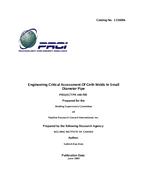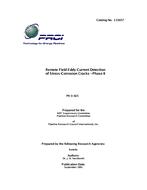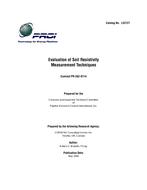Provide PDF Format
PRCI PR-140-709
- Engineering Critical Assessment of Girth Welds in Small-diameter Pipe
- Report / Survey by Pipeline Research Council International, 06/01/1989
- Publisher: PRCI
$98.00$195.00
L51600e
Welding Institute of Canada
Need: Transmission pipeline girth welds are fabricated and inspected to rigorous material standards such as API 1104, CSA Z 184 and BSI 4515. These standards contain weld defect acceptance levels based on good workmanship criteria and have been arrived at on the basis of traditional welding and inspection practices. In certain instances, defects that do not meet the workmanship standards have been accepted on the basis of an engineering critical assessment (ECA) using the British Standard PD 6493 assessment technique. The use of ECA is now being incorporated into the pipeline codes.
Result: Four girth welds containing hydrogen induced cracking (HIC) defects at the root were prepared in small diameter (305 mm) thin wall (6.35 mm) X52 pipes using E6010 (E41010) electrodes for the root and hot passes and E7010 (E48010) electrodes for the fill and capping passes. The CTOD tests were performed for the girth welds using each of HIC as well as fatigue pre-crack for the crack. The minimum, the average and an intermediate (between minimum and average) CTOD value at -40C obtained for the specimens containing HIC were used to determine the surface crack sizes for the girth weld roots from BS PD6493. The girth weld containing the 1/4 thickness HIC was full scale tested at -40C. The test was terminated when the remote strain gauges showed plastic deformation/ buckling in the pipe. The second and third full- scale girth weld tests were carried out with the half wall and an intermediate (between 1/4 and 1/2 wall) wall defect. In both cases the girth failed when the remote strain gauge readings in the pipe were still elastic.
Benefit: Preliminary studies have shown that there is a shift in behavior from thin to thick materials, with thinner materials being inherently tougher. The effect of thickness on dynamic transition temperature, as measured in the drop weight tear test, is well documented. Toughness data in thin wall material also indicates that higher toughness can be anticipated from these materials, in which case failure would be by plastic collapse. Various analyses have been valuated to address this failure mode. Fracture surfaces of both the full scale tests showed ligament yielding and tear at the defect location. The fracture mode along the girth circumference was mixed: both ductile and brittle.
Welding Institute of Canada
Need: Transmission pipeline girth welds are fabricated and inspected to rigorous material standards such as API 1104, CSA Z 184 and BSI 4515. These standards contain weld defect acceptance levels based on good workmanship criteria and have been arrived at on the basis of traditional welding and inspection practices. In certain instances, defects that do not meet the workmanship standards have been accepted on the basis of an engineering critical assessment (ECA) using the British Standard PD 6493 assessment technique. The use of ECA is now being incorporated into the pipeline codes.
Result: Four girth welds containing hydrogen induced cracking (HIC) defects at the root were prepared in small diameter (305 mm) thin wall (6.35 mm) X52 pipes using E6010 (E41010) electrodes for the root and hot passes and E7010 (E48010) electrodes for the fill and capping passes. The CTOD tests were performed for the girth welds using each of HIC as well as fatigue pre-crack for the crack. The minimum, the average and an intermediate (between minimum and average) CTOD value at -40C obtained for the specimens containing HIC were used to determine the surface crack sizes for the girth weld roots from BS PD6493. The girth weld containing the 1/4 thickness HIC was full scale tested at -40C. The test was terminated when the remote strain gauges showed plastic deformation/ buckling in the pipe. The second and third full- scale girth weld tests were carried out with the half wall and an intermediate (between 1/4 and 1/2 wall) wall defect. In both cases the girth failed when the remote strain gauge readings in the pipe were still elastic.
Benefit: Preliminary studies have shown that there is a shift in behavior from thin to thick materials, with thinner materials being inherently tougher. The effect of thickness on dynamic transition temperature, as measured in the drop weight tear test, is well documented. Toughness data in thin wall material also indicates that higher toughness can be anticipated from these materials, in which case failure would be by plastic collapse. Various analyses have been valuated to address this failure mode. Fracture surfaces of both the full scale tests showed ligament yielding and tear at the defect location. The fracture mode along the girth circumference was mixed: both ductile and brittle.
Related Products
PRCI PRCI
Back-Pressure Data On Natural-Gas Wells And Their Application To Production Practices..
$6.00 $12.00
PRCI PR-262-0114
Evaluation & Comparison of Soil Resistivity Measurement Techniques..
$98.00 $195.00




